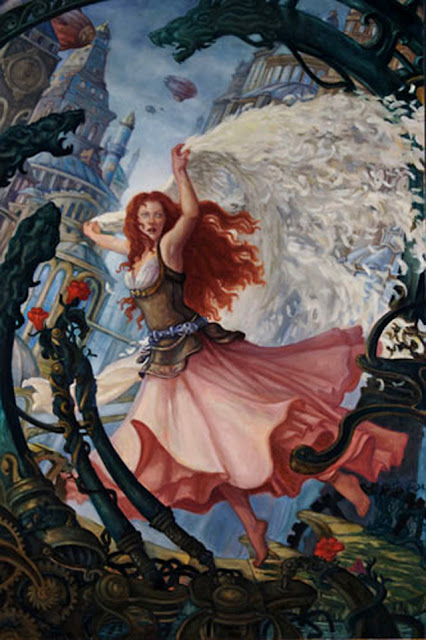Tonight's episode is called "Plumed Serpent" but with Juliette being abducted by a fire-breathing creature it's pretty clear Nick has to rescue his princess from the dragon - literally.
With Pixar's
Brave "I'll rescue myself" heroine on the way and Snow White in armor coming to theaters as well there is a lot of focus on the idea of "We finally have a princess that doesn't need a prince to save her!" I'm very happy to see this trend with regard to family movies and potential role models for girls. Even the mousiest and most retiring women I've met (and I've met a sad few) seem to harbor this secret wish they were stronger, sassier and could hold their own. (I say "even the mousiest" because, though you'd think they'd be the ones to faint if they ever saw a real weapon, I've found these women, even more than the rebels, are the ones fantasizing they could pick it up and use it.) I remember the first time I realized this. It helped me understand that despite all the apparent equality women have today, many still feel powerless and wish they didn't.
But while I'm cheering as much as everyone else about the heroine in
Brave in particular, I have to say this one thing - and it's a touchy subject: Is it so bad to be rescued
when you really need rescuing?
 |
| Elenor Abbott |
When it comes down to it,
everyone needs rescuing sometime (even our beloved kick-some-serious-butt Buffy!) and that includes every guy I've ever met. To NOT be rescued when you really need it is devastating but here's the thing: rescuing is rarely a one-man show. At the very least some cooperation is required from the rescue-ee. (And don't get me started about rescue-ees who don't really want to be rescued...) The problem I have is when people insist girls/women need to be rescued
all the time and don't give us the option to participate (also known as "help"). Women may not always come in swords flashing with the tactical savvy of a well-trained samurai but just because we're not Navy Seals doesn't mean we're helpless either. What's worse than people assuming this about women is when women assume this about themselves. THAT'S the part I have a problem with.
 |
| Corey Godbey |
The whole objection to having princesses waiting to be rescued is actually two-fold: the first, rarely discussed, part is where the princess allows herself to be put in the position of needing rescuing in the first place. Crap happens to everyone and even the smartest and most on-guard person can be forced into helplessness against their will but what we really want - need - is for girls and women to take ownership (and responsibility) of their situations as much as possible and stop being quite as vulnerable and therefore not need as much rescuing. The second part, where the "action" happens, is rarely as cut and dried as "you helpless/me rescue" - ask anyone who has ever been a victim of violence - but it's often portrayed that way in entertainment. Ultimately this does us all a disservice.
 |
| Edward Burne-Jones |
Ideally we want
everyone - men and women - to take whatever responsibility they can for their own safety and for the safety of those they care for, on every level. There will be times when we could all use a rescuing hand but that doesn't mean we have to be passive about it. It's like opportunity: it should be taken when it comes but you need to be prepared for it, because after that, the rest is up to you.
I'm aware this is the second post on the topic of women and violence (or women and passivity) in two days but I hope it's clear I'm not against "chicks with weapons". (Heck, I have a couple!) What I'm concerned about is having people - men and women - be forced into one extreme or other without allowing them to find their own balance according to their personality, strengths and weaknesses, which differ for everyone. Equally as important is taking responsibility for yourself as much as you can, no matter what situation you're in.
*steps down off soapbox*
I'm curious to see how this hot-button topic of a princess in need of rescue is handled in
Grimm this week. I hope there are some twists, some surprises and that there's more to this episode than killing the dragon to save the girl.
Here's the promo note: the original link apparently expired after the show aired so I'm replacing it with a YouTube version of the same):
I'm sure there are a bazillion excellent articles on the topic that have probably said things much better than I just have - or perhaps made arguments on the other end of the spectrum that should be considered - so if you know of one feel free to put the link in the comments so we can all have a read.
In the meantime I have to go do my workout and sharpen the tip of my foil... :)
































